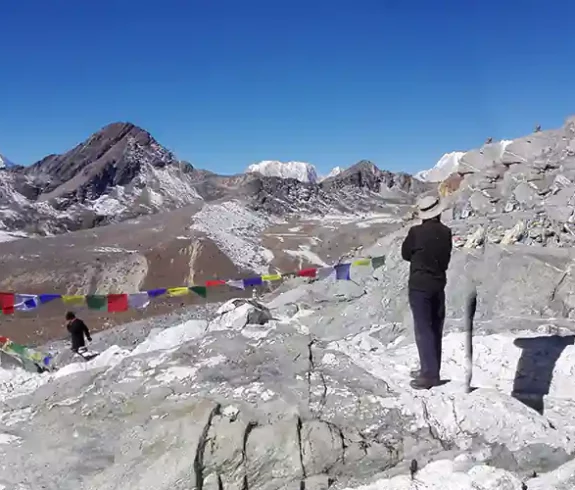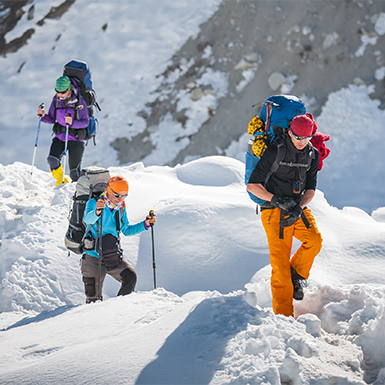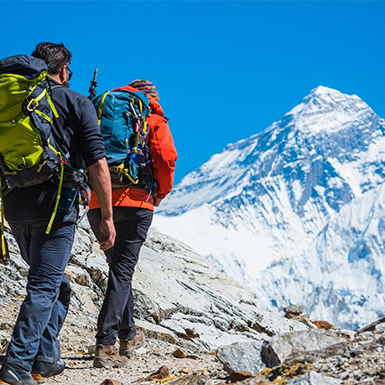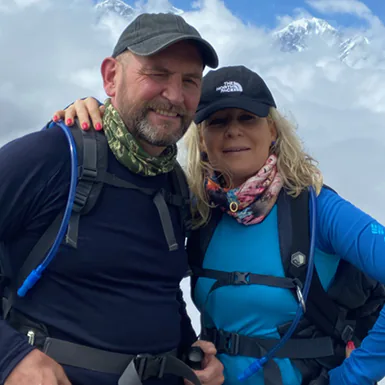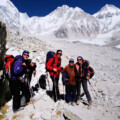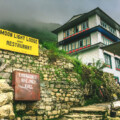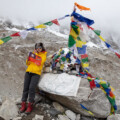Chola Pass, a dramatic feature of the Himalayan landscape, draws adventurers seeking physical and visual rewards. At a staggering 5,420 meters (17,782 feet), this high mountain pass isn’t just a geographical feature. It’s a rite of passage for those seeking adventure in the Everest region.
The Chola Pass trek is legendary, known for its demanding terrain and the unparalleled rewards it offers to those who conquer it. The pass bridges the stunning Gokyo Lakes and the iconic Everest Base Camp, making it a crucial part of many trekkers’ itineraries. It’s a place where physical endurance meets spiritual elevation and where the breathtaking beauty of the Himalayas unfolds in all its glory.

Location and Significance in Everest Region Treks
Where the Trails Converge
Chola Pass strategically lies in the Solukhumbu district of Nepal, within Sagarmatha National Park, a UNESCO World Heritage Site. The pass is a vital connector, linking the Gokyo Valley and the Khumbu Valley, the two main trekking routes in the Everest region.
A Crucial Junction on the Everest Chola Pass Trek
The Everest Chola Pass trek is a highly sought-after adventure, and crossing it is its crowning achievement. The trek typically begins in Lukla, the Everest region’s gateway, and winds through picturesque Sherpa villages, verdant forests, and glacial moraines. After exploring the serene Gokyo Lakes, trekkers face the challenging ascent to Chola Pass.
The Thrill of the Climb
Reaching the summit of Chola Pass is an exhilarating experience. From this vantage point, breathtaking vistas of Everest, Lhotse, Nuptse, and Ama Dablam unfold. The sense of accomplishment and the memories forged on this trek are truly unforgettable.
Chola Pass: A Confluence of History and Culture
Beyond its natural splendor and physical challenge, Chola Pass is rich in history and culture, deeply rooted in the local Sherpa community and the Everest region.
Echoes of the Past
- An Ancient Passage: Although its history is less extensively documented than some other Himalayan passes, Chola Pass likely facilitated trade for centuries, connecting the inhabitants of the Gokyo and Khumbu valleys. This exchange nurtured cultural and economic bonds between these communities.
- Pioneering Mountaineers: While Chola Pass might not have been their primary goal, early Everest expeditions in the 1920s and 1930s possibly crossed or explored the pass during their regional explorations. These intrepid endeavors contributed significantly to mapping and comprehending the Everest massif, forging a path for future climbers and trekkers.
Cultural Reverence of the Sherpa People
- Mountains as Sacred Ground: The Sherpa people, who have called the Everest region home for generations, hold the mountains, including Chola Pass, in deep reverence. They believe these majestic peaks serve as dwelling places for deities and spirits, approaching them with utmost respect and humility.
- Symbols of Devotion: As trekkers journey towards Chola Pass, they’ll encounter vibrant prayer flags dancing in the wind and mani stones inscribed with sacred mantras. These serve as offerings to the mountain deities, invoking blessings for a secure and successful passage.
- Celebrations and Traditions: The Sherpa people observe numerous festivals annually, some closely connected to the mountains. These gatherings often feature prayers, dances, and offerings to the deities, beseeching their protection and guidance.
Honoring the Cultural Legacy
When undertaking the trek to Chola Pass, it’s vital to be mindful of its cultural and spiritual significance to the Sherpa people.
- Embrace Local Customs: Dress modestly, especially when visiting monasteries or villages. Seek permission before capturing photos of people or religious artifacts.
- Tread Lightly: Carry out all waste and avoid disrupting the natural surroundings.
- Support the Community: Patronize local businesses and consider contributing to community-driven projects or initiatives.
Chola Pass: Navigating Nature’s Challenges
Chola Pass, a majestic gateway in the Himalayas, presents trekkers with breathtaking beauty and formidable challenges. Understanding its geographical nuances is critical to a safe and rewarding experience on the Everest Chola Pass trek.
Altitude: Scaling the Heights
Cho La Pass Altitude: Situated at a staggering 5,420 meters (17,782 feet) above sea level, Chola Pass demands respect and careful preparation. The high altitude poses risks like Acute Mountain Sickness (AMS), highlighting the importance of proper acclimatization.
Landscape: A Tapestry of Contrasts
- Dramatic Terrain: The Chola Pass trail presents a stunning tapestry of landscapes, transitioning from the lush greenery of valleys and forests to the stark beauty of rocky moraines and icy glaciers. The trail can be steep and uneven, requiring sure-footedness and trekking poles for support.
- Glacial Marvels: The pass is flanked by the Ngozumpa Glacier, the longest glacier in Nepal, offering a glimpse into nature’s raw power. Trekkers should prepare for icy patches and potential crevasses, especially in the early mornings or late season.
Weather: Unpredictable and Extreme
- Changeable Conditions: The weather in the Himalayas is notoriously fickle, and conditions change rapidly. Even in the peak trekking seasons, trekkers should anticipate everything from bright sunshine and clear skies to snowstorms and biting winds.
- Temperature Fluctuations: Temperatures can vary drastically, especially with changes in altitude and time of day. Layering is essential, allowing for adjustments as needed. Nights can be freezing, even in teahouses, so a warm sleeping bag is crucial.
Best Time to Trek
- Spring (March-May): Spring offers pleasant temperatures, blooming rhododendrons, and clear views. However, expect some crowds during this popular trekking season.
- Autumn (September-November): Another favorable window for trekking is autumn (September-November), offering stable weather, clear skies, and vibrant fall foliage. Post-monsoon, the trails are less dusty, and the air is crisp.
- Winter (December-February): While less crowded, trekking brings extreme cold, snow, and potential trail closures. It’s best suited for experienced trekkers with proper gear and knowledge.
- Monsoon (June-August): The monsoon season brings heavy rainfall, making trails slippery and challenging. While possible, trekking during monsoon is not recommended for most due to limited visibility and potential landslides.
Tips for a Successful Chola Pass Trek
- Acclimatize gradually: Ascend slowly, allowing your body to adjust to the high altitude. Incorporate rest days into your itinerary and listen to your body.
- Stay hydrated and fueled: Proper hydration and a nutrient-rich diet are crucial for combating altitude sickness and maintaining stamina during your trek.
- Pack wisely: Pack essential items such as layered clothing, reliable footwear, a high-quality sleeping bag, and other trekking gear.
- Hire a knowledgeable guide: A local guide can provide valuable insights, ensure your safety, and navigate challenging sections of the trail.
- Respect the environment and local culture: Contribute to sustainable tourism by trekking responsibly, reducing your footprint, and honoring local traditions.
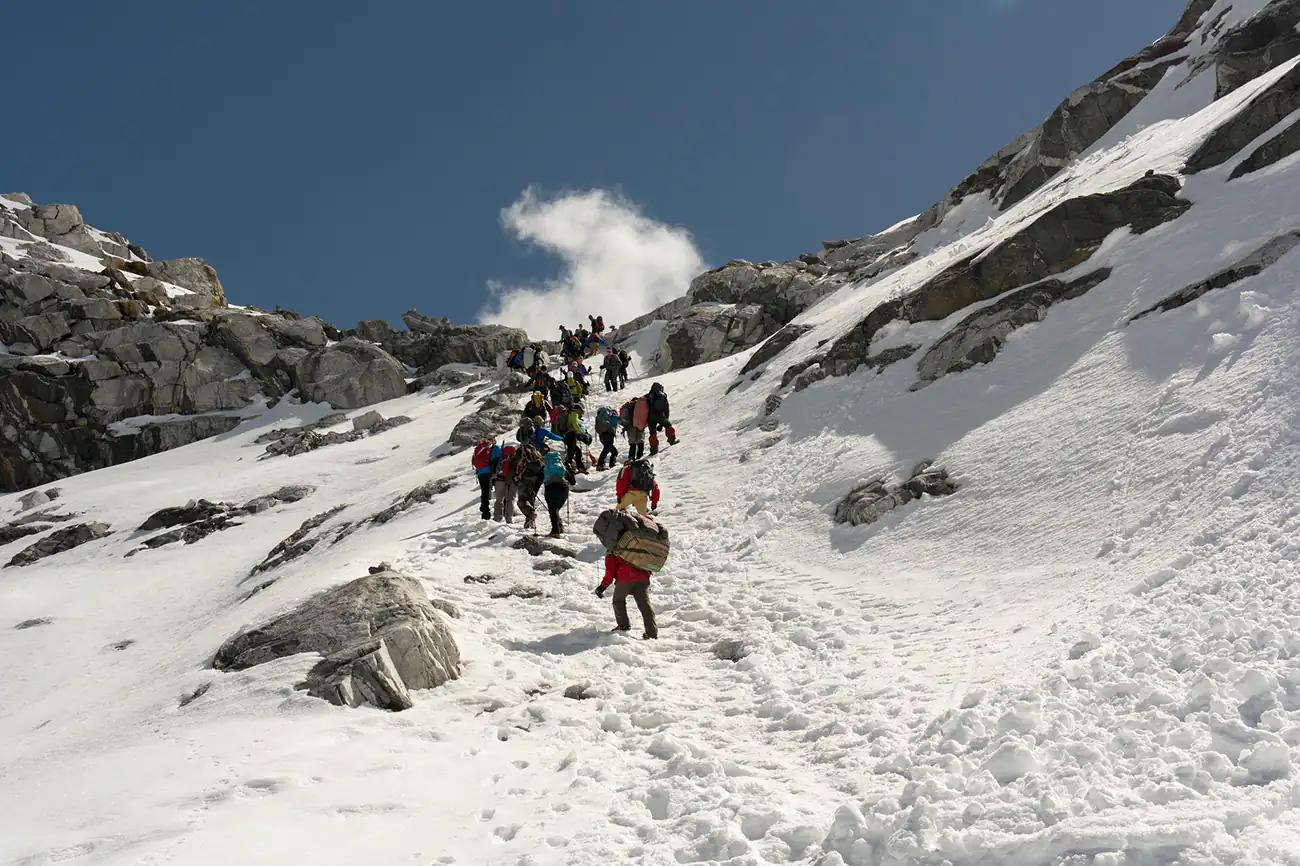
Trekking to Chola Pass: A Step-by-Step Guide
The trek to Chola Pass is an iconic trek through the heart of the Himalayas, offering stunning vistas and a challenging adventure. This guide maps out the route, identifies critical stages, and outlines the physical challenges.
Trekking Route and Key Stages
- Starting Point: Lukla: The Everest Chola Pass trek typically commences in Lukla, a small town in the mountains, accessible via a scenic flight from Kathmandu.
- Phakding and Namche Bazaar: The initial days involve trekking through picturesque Sherpa villages like Phakding and acclimatizing in the bustling hub of Namche Bazaar.
- Tengboche and Dingboche: The trail then ascends to Tengboche, home to a renowned Buddhist monastery, and Dingboche, a high-altitude settlement offering stunning views of Ama Dablam.
- Gokyo Lakes: A detour to the pristine Gokyo Lakes is a highlight. Here, you can witness the Ngozumpa Glacier and climb Gokyo Ri for panoramic mountain views.
- Dragnag and Chola Pass: From Gokyo, the trail leads to Dragnag, the final stop before the challenging ascent to Chola Pass. At 5,420 meters, Chola Pass pushes human endurance’s limits, demanding physical strength and mental fortitude.
- Dzongla and Lobuche: After crossing the pass, the descent takes you to Dzongla and then to Lobuche, the final stop before Everest Base Camp.
- Everest Base Camp and Kala Patthar: The trek reaches its pinnacle with a visit to the legendary Everest Base Camp, followed by an ascent of Kala Patthar for an unforgettable sunrise experience.
- Return via Gorakshep and Pheriche: The return trek retraces through Gorakshep and Pheriche, eventually descending to Namche Bazaar and Lukla.
Duration
The Everest Chola Pass trek typically spans 12-14 days, allowing for proper acclimatization and rest. However, the duration may vary depending on your pace, fitness level, and any side trips you choose to include.
Difficulty Level and Physical Challenges
- Challenging Trek: The Chola Pass trek is incredibly demanding, with high altitude, steep terrain, and long days. It’s suitable for experienced trekkers with good physical fitness and prior high-altitude trekking experience.
- Altitude Acclimatization: Acclimatization is crucial to prevent altitude sickness. The itinerary includes rest days to allow your body to adjust to the increasing elevation. It is critical to pay close attention to your body, maintain adequate hydration, and ascend gradually.
- Weather Conditions: Even in peak seasons, be prepared for unpredictable weather, including snow, rain, and strong winds. Pack appropriate clothing layers and gear to handle changing conditions.
- Mental Preparedness: The trek demands mental resilience and a positive attitude, especially during challenging sections and when facing altitude-related fatigue.
Everest Chola Pass Trek: A Comprehensive Guide
Chola Pass, a high-altitude mountain pass in the Everest region, is a significant highlight for trekkers seeking adventure and breathtaking landscapes. The Everest Chola Pass Trek is renowned for its challenging terrain and stunning views, connecting the Gokyo Valley with the Everest Base Camp route. Here’s a detailed itinerary and essential tips to help you navigate this trek.
Detailed Itinerary of the Everest Chola Pass Trek
Day 1: Arrival in Lukla and Trek to Phakding
- Take to the skies with a scenic flight from Kathmandu to Lukla, the starting point for your unforgettable trek. Your first destination is the idyllic village of Phakding, peacefully nestled along the Dudh Koshi River.
- Elevation: Lukla (2,860 m), Phakding (2,640 m)
- Trek Duration: 3-4 hours
Day 2: Phakding to Namche Bazaar
- The trail continues through pine forests and across suspension bridges. You will ascend to Namche Bazaar, the bustling hub of the Khumbu region.
- Elevation: 3,440 m
- Trek Duration: 5-6 hours
Day 3: Acclimatization Day in Namche Bazaar
Spend the day acclimatizing in Namche. You can hike to Syangboche or visit the Everest View Hotel for panoramic views of Everest, Lhotse, and Ama Dablam.
Day 4: Namche Bazaar to Dole
- The trek ascends through rhododendron forests to Dole, offering stunning views of Kangtega and Thamserku.
- Elevation: 4,090 m
- Trek Duration: 5-6 hours
Day 5: Dole to Machhermo
- Continue trekking through the valley, passing yak pastures and juniper bushes to reach Machhermo.
- Elevation: 4,410 m
- Trek Duration: 3-4 hours
Day 6: Machhermo to Gokyo
- Trek towards Gokyo, passing the beautiful Gokyo Lakes. The trail offers stunning scenery and tranquility.
- Elevation: 4,750 m
- Trek Duration: 5-6 hours
Day 7: Acclimatization Day in Gokyo
Hike to Gokyo Ri (5,357 m) for one of the best panoramic views in the Everest region, including Everest, Cho Oyu, and Makalu.
Day 8: Gokyo to Thangna
- Cross the Ngozumpa Glacier, the largest in the Himalayas, and head to Thangna, the base of Chola Pass.
- Elevation: 4,700 m
- Trek Duration: 4-5 hours
Day 9: Cross Chola Pass to Dzongla
- It is the most challenging day as you cross Chola Pass (5,368 m). The pass is steep and icy, requiring careful navigation.
- Trek Duration: 7-8 hours
Day 10: Dzongla to Lobuche
- A shorter day as you descend to Lobuche, preparing for the next leg towards Everest Base Camp.
- Elevation: 4,910 m
- Trek Duration: 3-4 hours
Day 11: Lobuche to Everest Base Camp and Back to Gorak Shep
- Reach Everest Base Camp, a significant milestone for any trekker, and return to Gorak Shep for the night.
- Elevation: 5,364 m (Base Camp)
- Trek Duration: 6-7 hours
Day 12: Gorak Shep to Kala Patthar and Descend to Pheriche
- Hike to Kala Patthar (5,545 m) for a close-up view of Everest, then descend to Pheriche.
- Trek Duration: 7-8 hours
Day 13: Pheriche to Namche Bazaar
- Retrace your steps downhill, savoring the more leisurely pace back to Namche Bazaar.
- Trek Duration: 6-7 hours
Day 14: Namche Bazaar to Lukla
- Continue descending to Lukla, where you’ll spend the night before flying back to Kathmandu.
- Trek Duration: 6-7 hours
Tips for Acclimatization and Managing Altitude Sickness
- Take it Slow: Ascend gradually to allow your body to adjust to the increasing altitude.
- Stay Hydrated: Drink plenty of water to help prevent altitude sickness.
- Rest Days: Utilize Namche Bazaar and Gokyo acclimatization days to let your body adjust.
- Recognize Symptoms: Be alert for altitude sickness symptoms, including headaches, dizziness, and nausea. If symptoms worsen, descend immediately.
- Consult a Doctor: Consider taking altitude sickness medication like Diamox after consulting a healthcare professional.
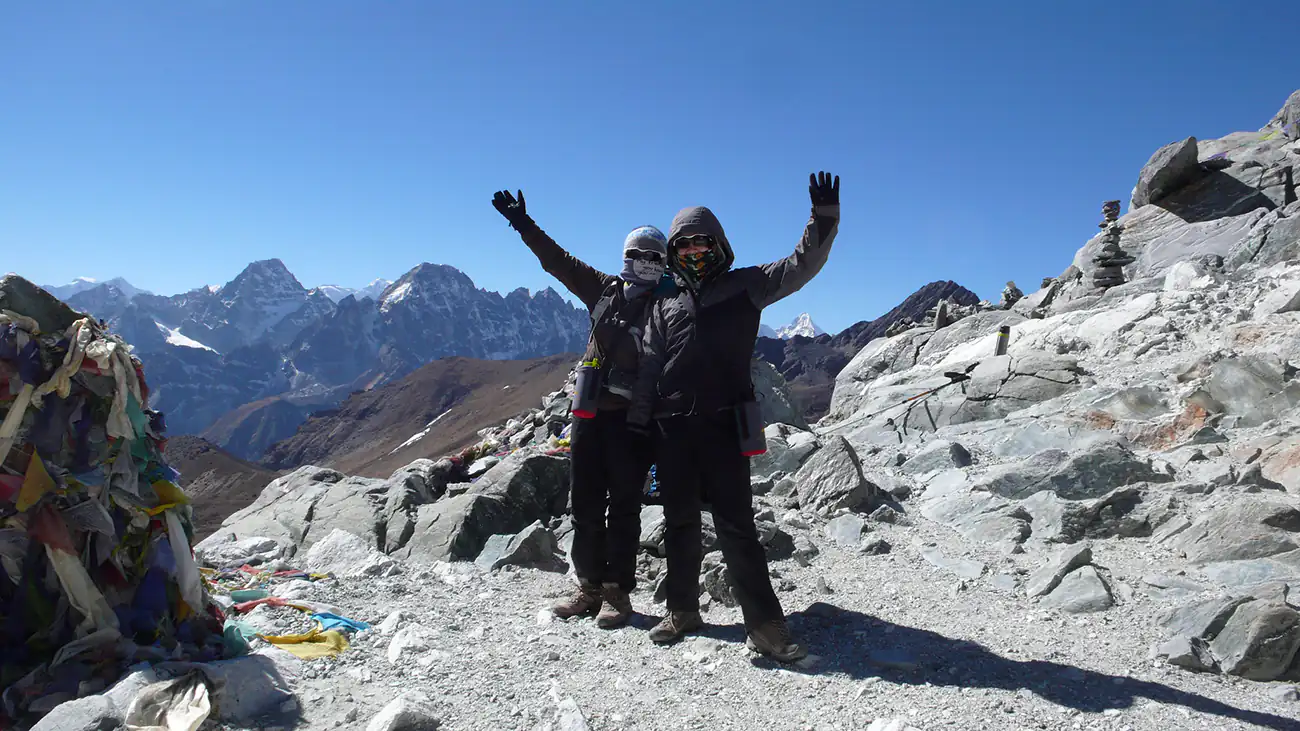
Gearing Up for Chola Pass: Essential Preparation
The Everest Chola Pass trek, reaching the daunting altitude of 5,420 meters at Cho La Pass, tests your physical limits and mental strength. Thorough preparation and the right packing list are your allies in conquering this challenge.
Gear Up for Success
- Footwear: Invest in sturdy, waterproof hiking boots with solid ankle support. Break them in well to avoid those dreaded blisters.
- Clothing: Layer up! The weather can change quickly. Pack moisture-wicking base layers, warm mid-layers (fleece or down), and a waterproof outer shell. Remember gloves, a hat, and a neck gaiter to keep the chill at bay.
- Backpack: Choose a comfortable and durable bag with a 50-60 liter capacity to carry your essentials. A rain cover is a brilliant addition for unexpected showers.
- Sleeping Bag: It is crucial to have a high-quality, warm sleeping bag rated for sub-zero temperatures. Nights at high altitudes can be surprisingly cold.
- Trekking Poles: These are your best friends on steep climbs and descents, relieving stress on your knees and providing balance.
- Headlamp/Flashlight: Essential for early morning departures, navigating in the dark, and unexpected situations.
- Sun Protection: The sun’s intensity increases with altitude, so pack sunglasses and high-SPF sunscreen to protect your eyes and skin.
- First-Aid Kit: A comprehensive first-aid kit with altitude sickness medication, pain relievers, and any personal medications you require is a must-have for your trek.
- Water Purification: To maintain good health, carry essential water purification equipment, such as a water filter or purification tablets.
Train Your Body, Prepare Your Mind
- Cardiovascular Fitness: Prioritize activities that boost endurance, such as running, hiking, cycling, or swimming. Aim for 3-4 weekly workouts, gradually increasing their duration and intensity.
- Strength Training: Focus on your legs, core, and back with exercises like squats, lunges, planks, and rows. Stronger muscles translate to better stability and reduced fatigue on the trail.
- Altitude Acclimatization: Acclimatize gradually by spending a few days at a higher altitude or using an altitude simulator.
- Mental Fortitude: Cultivate a positive mindset and mental resilience. This trek can be demanding, so anticipate long days, unpredictable weather, and potential obstacles.
Extra Tips for a Smooth Trek
- Break in Your Boots: Before the trek, take your new hiking boots for a few test runs to prevent blisters.
- Pack Smart: Prioritize essentials to minimize weight on your back.
- Stay Hydrated and Nourished: Drink plenty of water and eat nutritious meals throughout the trek.
- Listen to Your Body: Rest when necessary and avoid pushing yourself beyond your limits.

Safety First for an Unforgettable Adventure
The Everest Chola Pass trek promises breathtaking rewards, but navigating Chola Pass and its towering altitude of 5,420 meters demands careful attention to safety and intelligent navigation. Understanding potential risks and seeking experienced guidance is essential for a successful and worry-free trek.
Overcoming Challenges
- Altitude Sickness: Acute Mountain Sickness (AMS) is a severe concern at high elevations. Symptoms may include headaches, nausea, fatigue, and difficulty breathing. Proper acclimatization and recognition of early signs are crucial.
- Unpredictable Weather: The Himalayan weather can be fickle and harsh. Trekkers should be ready for sudden snowstorms, strong winds, and plunging temperatures.
- Demanding Terrain: The Chola Pass trail features steep climbs and descents, rocky stretches, and glacier crossings. These can be challenging and slippery, especially in bad weather.
- Navigation Hurdles: Snow or fog can obscure the trail, making it difficult to find your way.
- Physical Fatigue: High altitude, challenging terrain, and long days on the trail can lead to exhaustion. Maintain a steady pace, prioritize hydration, and pay attention to your body’s cues.
Navigating Chola Pass: Expert Tips
- Hire a Guide: An experienced local guide familiar with the Everest Chola Pass trek and Chola Pass’s unique challenges is invaluable. They prioritize your safety, navigate the route confidently, and share insights into the local culture and surroundings.
- Use Trail Markers and Maps: While helpful, don’t rely solely on trail markers or maps. Weather can hide markers, and maps might only partially be accurate.
- Early Bird Gets the Worm: Start your trek early, especially when crossing Chola Pass. It allows you to turn back if the weather deteriorates or unexpected challenges occur.
- Acclimatize Smartly: Make acclimatization a priority. Include rest days in your itinerary and ascend gradually. It minimizes the risk of altitude sickness and helps your body adapt to the thin air.
- Strength in Numbers: Trek with a group for added safety. You can offer mutual support, share the load, and boost each other’s morale throughout the trek.
- Stay Connected: Carry a satellite phone or other reliable emergency communication device.
Finding Comfort Amidst the Mountains
Even though the Everest Chola Pass trek is famous for its rugged beauty and challenging paths, you’ll find comfortable places and essential amenities. Planning and knowing your options will make your experience even more enjoyable.
Where to Rest Your Head
- Tea Houses: Your Home Away from Home: Tea houses are the most common Everest Chola Pass trek accommodation. They provide simple yet cozy rooms with shared bathrooms and dining areas. You can find tea houses in most villages and even at higher altitudes near Chola Pass.
- Lodges: A Touch of Luxury: In larger villages like Namche Bazaar and Dingboche, lodges offer slightly more upscale amenities like private rooms and en-suite bathrooms. Keep in mind that these can be more expensive than tea houses.
- Camping: Embrace the Wild: Although less common on this particular route, some trekkers prefer camping for its flexibility and solitude. Packing your tent, sleeping bag, and cooking equipment is necessary for this trip.
Fueling Your Adventure
- Tea House Meals: A Taste of Nepal: Most tea houses serve various dishes, including Nepali staples like dal bhat (rice and lentil soup), alongside Western favorites like pasta and pizza. The food is usually straightforward but filling and packed with energy.
- Packed Lunches: Fuel for the Trail: On trekking days, you can ask your tea house to prepare a packed lunch. It typically includes sandwiches, fruit, and snacks to keep you going.
- Stay Hydrated: Pure Water is Key: Tea houses sell bottled water, but it’s more eco-friendly and often safer to carry a reusable water bottle and purify your water. Boiling, using purification tablets, or filtering are all effective methods.
Taking Care of Yourself
- Basic First Aid is Available: Most tea houses have basic first-aid supplies, and some lodge owners or guides also have basic medical training.
- Health Posts for Peace of Mind: Significant villages like Namche Bazaar and Pheriche have health posts. Healthcare professionals staff these facilities, offering primary medical care and advice.
- Emergency Evacuation: Just in Case: Although costly, helicopter rescue services are available for severe illness or injury. Comprehensive travel insurance, including high-altitude coverage and emergency evacuation, is essential.
Conservation and Environmental Impact
With its challenging Cho La Pass altitude and awe-inspiring vistas, the Everest Chola Pass trek is a pristine Himalayan gem worth safeguarding. As we venture into this delicate ecosystem, let’s tread lightly and minimize our environmental impact.
Trekking’s Footprint
While trekking boosts the local economy, it also presents environmental challenges. These include:
- Waste Woes: Carelessly discarded waste like food scraps, plastic bottles, and toilet paper can spoil the landscape and pollute water sources.
- Forest Loss: The demand for firewood for cooking and warmth can lead to deforestation, upsetting the ecosystem’s delicate balance.
- Erosion Concerns: Heavy foot traffic can accelerate erosion, especially on vulnerable trails and slopes.
- Wildlife Disruption: Noise and human activity can disturb the local wildlife, impacting their natural behavior and habitat.
Conservation in Action
Local communities, trekking agencies, and the Sagarmatha National Park authorities are taking steps to protect this environment.
- Waste Solutions: They encourage trekkers to pack their trash, promote reusable water bottles, and set up waste collection points along the route.
- Cleaner Energy: They advocate using kerosene or solar power instead of firewood for cooking and heating.
- Trail Upkeep: They regularly maintain and improve trails to reduce erosion and protect delicate plant life.
- Wildlife Protection: They educate trekkers about responsible wildlife viewing and restrict access to sensitive areas.
Capture Memories That Last a Lifetime
The Everest Chola Pass trek isn’t just a physical challenge; it’s a feast for the eyes. The dramatic landscapes, towering peaks, and unique cultural encounters provide endless opportunities for breathtaking photography. Here’s how to capture the essence of Chola Pass and create memories that will inspire you for years to come.
Photography Tips for the Chola Pass Trek
- Gear Up: Bring a reliable camera with a versatile lens. Consider a wide-angle lens for capturing panoramic vistas and a telephoto lens to zoom in on distant peaks. A lightweight tripod can be helpful for low-light situations and for capturing sharp images.
- Embrace the Golden Hour: The soft, warm light of sunrise and sunset casts a magical glow on the mountains. Take advantage of these golden hours for stunning photographs.
- Focus on Composition: Compose visually striking images by employing the rule of thirds, utilizing leading lines, and strategically framing your subjects. Feel free to experiment with different perspectives and angles.
- Capture the Details: Pay attention to the small details that make Chola Pass unique. Capture the texture of the rocks, the vibrant colors of prayer flags, or the friendly smiles of local Sherpa people.
- People Add Perspective: Include people in your shots to give a sense of scale and showcase the human element in this vast landscape.
- Be Patient and observe: Rapid weather changes are common in the mountains. Wait for those perfect moments when the clouds part and the sun shines through. Look for exciting wildlife and cultural events.
